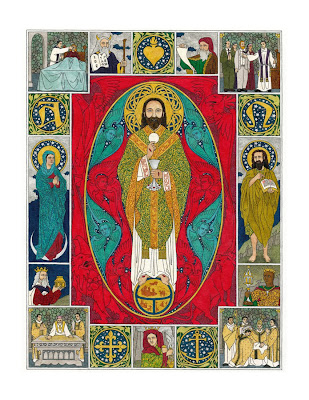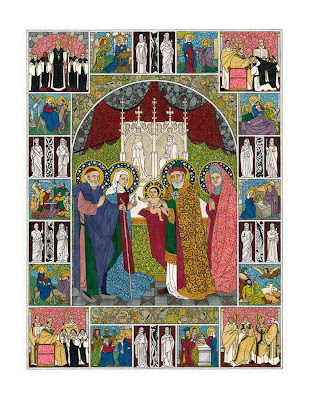![]()
We are quickly progressing through Advent, and indeed, we are now only a few days shy of Gaudete Sunday. Gaudete Sunday, like Laetare Sunday within Lent, sees the liturgical colour of rose used -- and of course, this applies to both the modern and ancient Roman liturgy.
Sadly, I have seen many a church or chapel where rose vestments, being used only two Sundays of the liturgical year, are simply dispensed with -- which is to say they don't have them, not that they have them but do not use them. In some instances this may be for legitimate pragmatic reasons, but no doubt in many other instances the thought has simply been that for such infrequent liturgical use, why make the investment? Or at very least, why make it any sort of priority to acquire them? As a counter-point, I would suggest that the Church does not put forth these things frivolously. Evidently there are symbolic meanings associated with this usage, just as in the case of the other liturgical colours, and these have something to teach us and indeed provide a teaching moment. As such, how often they might be used does not in anyway make them of any less importance, and indeed, if we take the central importance of the sacred liturgy, of divine worship, seriously, then we should not take a minimalist view about these things.
Speaking of the Third Sunday of Advent, Dom Gueranger comments:
Today, again, the Church is full of joy, and the joy is greater than it was. It is true that her Lord has not come; but she feels that He is nearer than before, and therefore she thinks it just to lessen somewhat the austerity of this penitential season by the innoncent cheerfulness of her sacred rites... The organ is played at the Mass; the vestments are rose-colour; the deacon resumes the dalmatic, and the subdeacon the tunic [this is in reference to the folded chasubles which would have been worn by deacon and subdeacon on the other days of Advent at this time -- NLM]; and in cathedral churches the bishop assists with precious mitre. How touching are all these usages, and how admirable this condescension of the Church, wherewith she so beautifully blends together the unalterable strictness of the dogmas of the faith and the graceful poetry of the formulae of the liturgy!
Evidently, some of these elements are no longer strictly observed and some have been dispensed with altogether in recent decades (which is worthy of a whole other discussion, but I digress); the main point here is that, whatever else might have added to this, the use of rose helps to tie into this spirit of gladness and joyfulness which the Church wishes to present to us -- which further says something to us about the rest of the season as well.
But let us turn our attention now to vestments themselves.
Over the years we have shown you many examples of rose coloured vestments -- both new and old. Sometimes we have commented on particulars around colour choices and what might or might not work well from a design perspective -- after all, our worship of God deserves ornaments that befit that solemn duty, as do the sacred mysteries. I do not intend to do that this year, nor do I intend to show you those we have already shown you in the past; those are readily available in the archives. Instead, I would like to show you some rose vestments which we have not shown you before.
This first was only recently made; generally speaking, this sort of "salmon" shade of rose is one which I, myself, personally favour:
The next comes from the FSSP Rome from the sacristy of their former church of San Gregorio dei Muratori:
Here is another of very early 19th century vintage (indeed, it looks more 18th century than what we might think of as 19th):
Finally, I recently came across
this example as well, which looks rather tasteful if the picture is accurately reflecting it:
Those then are some rose vestments we have not shown before, but if you would like to see some of the other examples of rose vestments we have shown over the years, you may want to look at
this post and
this one as well. These will show you some examples which I think particularly successful.
![]()
































